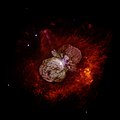Файл:Eta Carinae.jpg

Размер на този преглед: 600 × 599 пиксела. Други разделителни способности: 240 × 240 пиксела | 480 × 480 пиксела | 769 × 768 пиксела | 1025 × 1024 пиксела | 2015 × 2013 пиксела.
Оригинален файл (2015 × 2013 пиксела, големина на файла: 163 КБ, MIME-тип: image/jpeg)
История на файла
Избирането на дата/час ще покаже как е изглеждал файлът към онзи момент.
| Дата/Час | Миникартинка | Размер | Потребител | Коментар | |
|---|---|---|---|---|---|
| текуща | 09:41, 18 декември 2017 |  | 2015 × 2013 (163 КБ) | The NMI User | Reverted to version as of 14:14, 1 May 2008 (UTC) |
| 14:45, 13 март 2017 |  | 3000 × 2998 (1,18 МБ) | Leogorgon | larger file size | |
| 14:14, 1 май 2008 |  | 2015 × 2013 (163 КБ) | Vol de nuit | {{Information |Description=(NASA News Release) A huge, billowing pair of gas and dust clouds are captured in this stunning NASA Hubble Space Telescope image of the supermassive star Eta Carinae. Using a combination of image processing techniques (ditheri |
Използване на файла
Няма страници, използващи файла.
Глобално използване на файл
Този файл се използва от следните други уикита:
- Употреба в da.wikipedia.org
- Употреба в en.wikipedia.org
- Star
- Eta Carinae
- Wikipedia:Selected anniversaries/March 11
- Wikipedia:Today's featured article/March 2017
- Wikipedia:WikiProject Wikipack Africa Content/Wikipedia:Showcase
- Wikipedia:WikiProject WikiFundi Content/Eta Carinae
- Wikipedia:Today's featured article/requests/Eta Carinae
- Wikipedia:Today's featured article/March 12, 2017
- Wikipedia:Main Page history/2017 March 12
- Wikipedia:WikiProject WikiFundi Content/Wikipedia:Showcase
- Wikipedia:Main Page history/2022 March 11
- Wikipedia:Main Page history/2022 March 11b
- Wikipedia:Main Page history/2023 March 11
- Wikipedia:Main Page history/2023 March 11b
- User:2003 LN6/sandbox/Eta Carinae variable
- List of luminous blue variable stars
- Употреба в en.wikiversity.org
- User:Marshallsumter/Radiation astronomy2/Visuals
- User:Marshallsumter/Radiation astronomy2/Violets
- Stars/Astronomy
- User:Marshallsumter/Radiation astronomy2/Violets/Quiz
- Stars/Sun/Astronomy/Quiz
- User:Marshallsumter/Radiation astronomy/Courses/Principles/Hourly 2
- User:Marshallsumter/Radiation astronomy/Courses/Principles/Final quiz
- Draft:Original research/Io/Quiz
- Titan/Quiz
- Stars/Solar systems/Quiz
- Moon/Quiz
- Earth/Quiz
- User:Marshallsumter/Radiation astronomy/Colors/Quiz
- Volcanoes/Io/Quiz
- Stars/Violets
- User:Marshallsumter/Radiation astronomy2/Stars
- Stars/Violets/Quiz
- Употреба в es.wikipedia.org
- Употреба в fr.wikipedia.org
- Употреба в hi.wikipedia.org
- Употреба в it.wikibooks.org
- Употреба в la.wikipedia.org
- Употреба в mk.wikipedia.org
- Употреба в ms.wikipedia.org
- Употреба в my.wikipedia.org
- Употреба в oc.wikipedia.org
- Употреба в ru.wikipedia.org
- Употреба в sk.wikipedia.org
- Употреба в sr.wikipedia.org
- Употреба в th.wikipedia.org
Преглед на глобалната употреба на файла.
